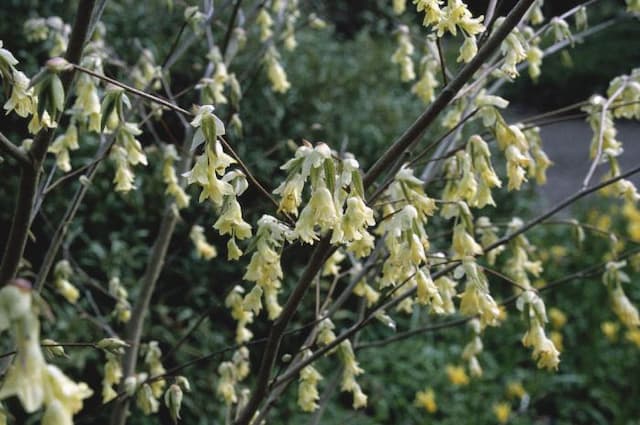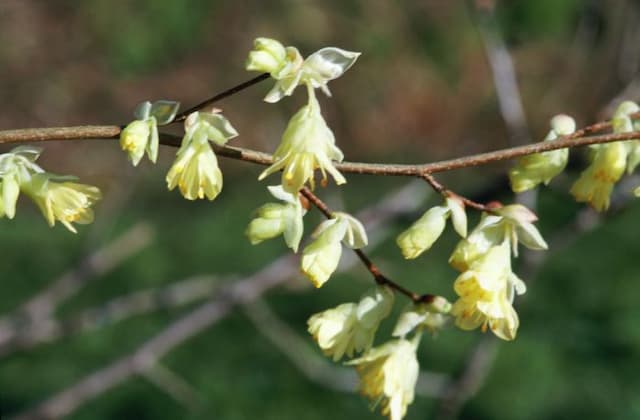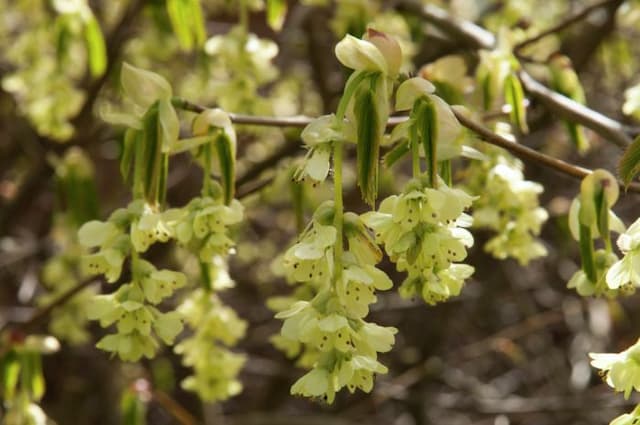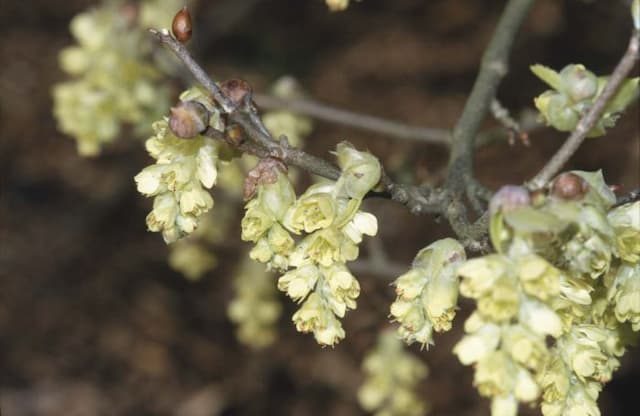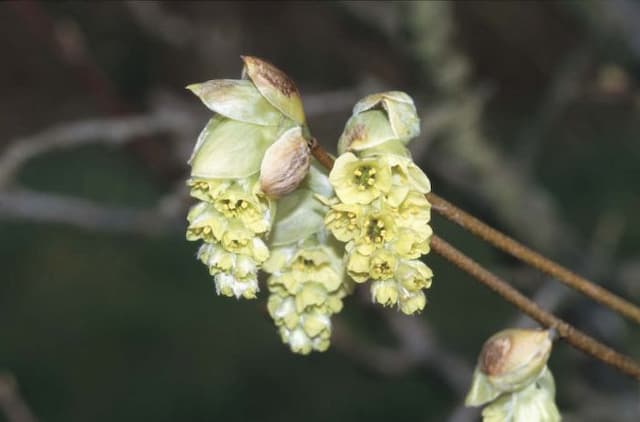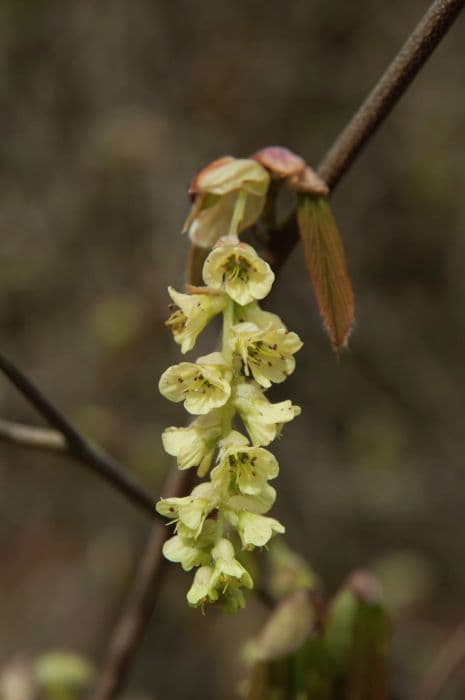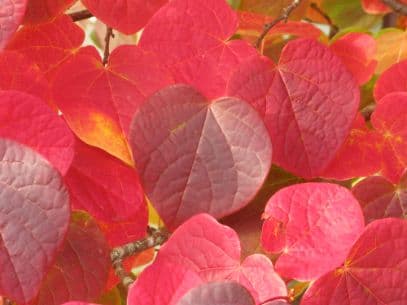Witch Hazel Hamamelis × intermedia 'Arnold Promise'

ABOUT
The witch hazel 'Arnold Promise' is an ornamental plant renowned for its unique and striking flowers. This plant displays a visually stunning display of vibrant yellow flowers that bloom during the late winter to early spring, often while the rest of the garden is dormant. The flowers are ribbon-like with four crinkled, strap-shaped petals that unfurl from winter buds and spread outwards, creating a burst of color that contrasts beautifully against the bare branches. The blossoms emit a sweet and refreshing fragrance that can be noticed when strolling near the plant, contributing to the sensory appeal of the garden during the colder months. As the flowering season concludes, the plant ushers in the spring with fresh green foliage which can turn to attractive shades of yellow in the fall, offering a prolonged display of seasonal interest. The leaves are oval to broadly lance-shaped with a wavy or slightly toothed margin that provides texture to the foliage. Witch hazel 'Arnold Promise' has a vase-shaped spreading habit, and its branches are arranged in a way that allows the yellow flowers to be presented against the winter sky, maximizing their visual impact. The bark is smooth and gray-brown, offering a subtle yet appealing aspect of the plant's character during the dormant season. Overall, this particular variety of witch hazel is cherished for its vibrant blossoms in the winter garden, sweet fragrance, and its year-round contribution to the landscape aesthetic.
About this plant
 Names
NamesFamily
Hamamelidaceae.
Synonyms
Arnold Promise Witch Hazel.
Common names
Hamamelis × intermedia 'Arnold Promise'
 Toxicity
ToxicityTo humans
Witch Hazel 'Arnold Promise' is not commonly listed as a toxic plant to humans. However, as with many plants, it is not intended for ingestion. In the absence of widely recognized toxic effects, it is still advisable to exercise caution and keep plant material out of reach of children, as individual reactions to plants can vary, and ingesting plant parts could potentially cause discomfort or an allergic reaction in some susceptible individuals.
To pets
Witch Hazel 'Arnold Promise' is generally not considered poisonous to pets. Pets should not be encouraged to eat ornamental plants as some parts may cause irritation or mild stomach upset if ingested. It is always a good practice to monitor your pets and prevent them from chewing on plants, both indoors and outdoors, to avoid any potential issues.
 Characteristics
CharacteristicsLife cycle
Perennials
Foliage type
Deciduous
Color of leaves
Green
Flower color
Yellow
Height
12 feet [3.66 meters]
Spread
12 feet [3.66 meters]
Plant type
Shrub
Hardiness zones
5
Native area
Japan China
Benefits
 General Benefits
General Benefits- Winter Interest: 'Arnold Promise' witch hazel flowers in late winter, providing color and beauty during a season when few other plants are blooming.
- Attractive Flowers: It boasts fragrant, bright yellow flowers that are eye-catching and add aesthetic value to winter gardens.
- Wildlife Attraction: The blossoms provide a source of nectar for early-emerging pollinators looking for food at the end of winter.
- Fall Foliage: In addition to winter blooms, it features vibrant fall foliage, offering a display of yellow to orange-red leaves.
- Adaptable: This plant is adaptable to a variety of soil types, although it prefers well-drained, loamy soils.
- Cold Hardy: Witch hazel is known for being tolerant of cold temperatures, making it suitable for growing in many climates.
- Low Maintenance: Once established, it requires minimal care, making it an excellent choice for gardens where low maintenance is a priority.
- Architectural Shape: Its vase-shaped growth habit can add structural interest to the garden landscape.
- Erosion Control: The shrub's root system can help stabilize soil and prevent erosion, especially on slopes.
- Privacy and Screening: Can be used as a screening plant to provide privacy in the garden due to its size and density when mature.
 Medical Properties
Medical PropertiesThis plant is not used for medical purposes.
 Air-purifying Qualities
Air-purifying QualitiesThis plant is not specifically known for air purifying qualities.
 Other Uses
Other Uses- Winter Interest: The 'Arnold Promise' witch hazel blooms in late winter with bright yellow flowers that are a rare source of color during the colder months.
- Photography: Because of its early bloom time and distinctive flowers, it is often used by garden photographers looking for unique plant subjects during the winter season.
- Winter Gardens: The shrub is popular in winter gardens where it provides structure and interest during a time when most other plants are dormant.
- Bonsai: 'Arnold Promise' witch hazel can be trained as a bonsai specimen, providing a unique challenge for enthusiasts of this art form.
- Screening: When planted in groups, the dense foliage of witch hazel can be used to create a natural privacy screen in the garden.
- Educational Use: Botanical gardens and educational institutions may use 'Arnold Promise' witch hazel to teach students and visitors about phenology, the study of cyclic and seasonal natural phenomena.
- Floral Arrangements: The bright yellow, fragrant flowers are sometimes used in floral arrangements, particularly in winter when flowers are scarce.
- Perfumery: Occasionally, the extract from the flowers may be used in perfumery for its unique fragrance notes.
- Cultural Symbolism: Sometimes witch hazel is planted in gardens designed with Feng Shui principles in mind, where it may be used to attract positive energy during the winter time.
- Wildlife Gardens: Witch hazel can be incorporated into wildlife gardens as its seed capsules provide food for various birds and small mammals.
Interesting Facts
 Feng Shui
Feng ShuiThe Witch Hazel is not used in Feng Shui practice.
 Zodiac Sign Compitability
Zodiac Sign CompitabilityThe Witch Hazel is not used in astrology practice.
 Plant Symbolism
Plant Symbolism- Healing: As a member of the witch hazel family, 'Arnold Promise' is often associated with healing because witch hazel extracts are commonly used for their medicinal properties.
- Hope: Blooming in late winter, sometimes when snow is still on the ground, it symbolizes hope and the anticipation of spring.
- Resilience: Its ability to bloom in cold conditions makes it a symbol of resilience and the idea of overcoming challenges.
- New Beginnings: The early bloom represents new beginnings and the start of a cycle, coinciding with the fresh start provided by the New Year.
- Uniqueness: With its distinct late-winter flowers, 'Arnold Promise' can be seen as a symbol of uniqueness and standing out from the crowd.
- Adaptability: Its versatility and ability to thrive in various conditions can symbolize adaptability and the ability to prosper in different environments.
 Water
WaterWitch Hazel 'Arnold Promise' prefers evenly moist, well-drained soil and should be watered deeply once a week, providing about 1 to 1.5 gallons per watering for newly established plants. During the growing season, especially in the absence of rainfall, maintaining consistent moisture levels is important but be cautious to not overwater, as this can lead to root rot. During the dormant season in winter, watering can be reduced but not completely stopped, as the root system still requires moisture. Always adjust your watering schedule based on rainfall, temperature, and soil conditions.
 Light
LightWitch Hazel 'Arnold Promise' thrives in full sun to partial shade. The ideal location provides morning sunlight and protection from the intense afternoon heat. It can tolerate some shade but flowering and fall color are best with a good amount of sunlight.
 Temperature
TemperatureWitch Hazel 'Arnold Promise' can withstand a wide range of temperatures, growing well in hardiness zones 5 through 8. It can tolerate winter lows reaching down to around -20°F and is comfortable at summer highs up to 90°F. The ideal growing temperatures for this shrub are between 60°F and 75°F during the growing season.
 Pruning
PruningWitch Hazel 'Arnold Promise' should be pruned to maintain shape and remove any damaged or crossing branches, typically after it has finished blooming in late winter or early spring. Pruning at this time allows for a good display of flowers the following season. Minimal pruning is necessary, focusing only on maintaining an attractive form and removing any problematic growth.
 Cleaning
CleaningAs needed
 Soil
SoilWitch Hazel 'Arnold Promise' thrives in well-draining, loamy soil that is rich in organic matter. Aim for a soil pH between 5.5 and 6.5. The best soil mix can be created by combining equal parts of garden soil, peat moss, and perlite or coarse sand to ensure good drainage and aeration.
 Repotting
RepottingWitch Hazel 'Arnold Promise' does not require frequent repotting as it is typically grown as a large shrub or small tree in the landscape. It should only be repotted or transplanted if necessary due to size or soil exhaustion, which might occur every few years.
 Humidity & Misting
Humidity & MistingWitch Hazel 'Arnold Promise' is adaptable to a wide range of humidity conditions and does not have specific humidity requirements. It grows well in outdoor conditions where the humidity level is naturally regulated by the environment.
 Suitable locations
Suitable locationsIndoor
Not ideal for indoor cultivation; needs space and sun.
Outdoor
Plant in sun to partial shade, amend soil with organic matter.
Hardiness zone
5-8 USDA
 Life cycle
Life cycleThe life cycle of Hamamelis × intermedia 'Arnold Promise', commonly known as Witch Hazel 'Arnold Promise', begins with seed germination, which occurs in the spring after a period of stratification that mimics winter-like conditions. Following germination, the seedling grows, developing a robust root system and foliage through the vegetative stage. As the plant matures, it enters the flowering stage, typically in late winter to early spring, before the leaves unfurl, displaying fragrant yellow flowers. After pollination, usually by insects that are active during cooler temperatures, the plant produces seed capsules that mature in the fall, eventually splitting open to disperse seeds. The plant continues to grow and develop a woody structure as a deciduous shrub, achieving maturity in several years, and can live for many years, flowering annually. During its lifespan, the Witch Hazel 'Arnold Promise' undergoes seasonal changes, losing leaves in the fall and entering dormancy during the winter, until environmental cues trigger the next cycle of growth and flowering.
 Propogation
PropogationPropogation time
Late winter
The Witch Hazel 'Arnold Promise' is generally propagated in late winter or early spring, before new growth begins. The most popular method of propagation for this shrub is through softwood cuttings. This process involves selecting healthy, new growth stems from the current year's growth. Typically, a cutting of about 4 to 6 inches (10 to 15 cm) is taken, and the lower leaves are removed. The cut end of the stem is often dipped in a rooting hormone to encourage root development, and then the cutting is placed in a well-draining potting mix. The environment should be kept humid, and the soil moist but not waterlogged, to foster rooting. After several weeks to a few months, the cuttings will develop roots and can be transferred to individual pots to grow on before eventually being planted out in the garden.
